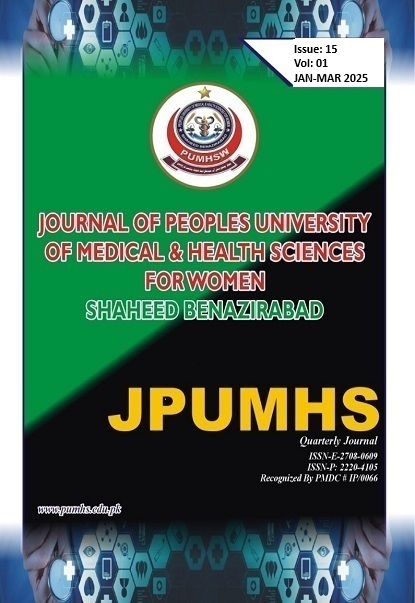PREVALENCE AND RISK FACTORS OF PRE-ECLAMPSIA IN PREGNANT WOMEN: A CROSS-SECTIONAL STUDY AT A TERTIARY CARE HOSPITAL.
JPUMHS; 2025:15:01,195-202. http://doi.org/10.46536/jpumhs/2025/15.01.613
Keywords:
pre-eclampsia; maternal mortality; rural health; Pakistan; pregnancy outcomes.Abstract
BACKGROUND: Pre-eclampsia (PE) significantly contributes to maternal and perinatal
mortality rates and is particularly prevalent in resource-limited regions. In rural Pakistan, where
healthcare disparities are pronounced, there is a lack of comprehensive data regarding PE
epidemiology. OBJECTIVE: This study aimed to determine the prevalence, risk factors, and
clinical outcomes associated with PE among pregnant women in rural Sindh, Pakistan.
METHODS: A cross-sectional study conducted at a tertiary care facility enrolled 1,800
pregnant participants. PE was identified using ACOG guidelines. Researchers collected
sociodemographic information, medical histories, and pregnancy outcomes using structured
questionnaires and clinical assessments. Adjusted odds ratios (aOR) were calculated using
multivariable logistic regression. RESULTS: The prevalence of PE was found to be 6%,
exceeding the rates observed in urban Pakistan (4–5%). Key risk factors included primigravida
status (aOR = 2.5, 95% CI: 1.6–3.8), chronic hypertension (aOR = 4.2), and obesity (aOR =
3.8). A family history of PE increased the risk by twofold (aOR = 2.1). The rural healthcare
landscape revealed stark inequalities: 70% of PE patients lived more than 50 km from
healthcare facilities, with 58% of these individuals having low household incomes.
Complications linked to PE included eclampsia (11.1% compared to 0.4% in non-PE
pregnancies), preterm delivery (50%), and low birth weight (44.4%). Only 35% of rural women
accessed four or more antenatal visits nationally. CONCLUSION: In rural Sindh, PE is driven
by biological vulnerabilities, poverty, and systemic deficiencies in healthcare. Immediate
action is required to address obesity, hypertension, and access to medical services. Community-
level screening, ensuring magnesium sulfate availability, and maternal education initiatives
could help mitigate preventable health issues. This research highlights the urgent necessity for
cohesive strategies to tackle PE in low-resource environments.
Downloads
Downloads
Published
How to Cite
Issue
Section
License

This work is licensed under a Creative Commons Attribution-NoDerivatives 4.0 International License.




